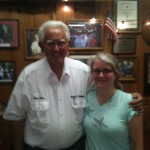 When people ask me about Twitter, they can hear how enthusiastic I am,
When people ask me about Twitter, they can hear how enthusiastic I am,
and how many connections I’ve made, and how I wax on and on
about what I find so interesting about it.
But I find that I usually begin these conversations with…”It’s kind of hard to explain, you just have to try it….” Sometimes I think novices to Twitter might feel like I do, when I’m looking at retired parents’ neatly kept homes and I think that they sprung up fully formed as organized parents. Seeing only where they are now, it seems that you could never get there. Similarly, as newbies to Twitter, it’s easy to think that people spring into a network “fully formed.” ( Or to carry the analogy to BBQ, it’s like they are looking at the pot of beans as a fully-formed whole, without considering all the time and separate ingredients that went into it.)
I’m wondering if maybe we should talk about networks and Twitter somewhat differently than we are. I didn’t join Twitter to “build a network.” I just saw a few years ago that it was being used at SXSW(the renowned Austin music festival), and that gave it some panache, so I just thought I’d try it out. After watching how it was being used at SXSW, it dawned on me this could be pretty useful at conferences for finding people who I knew only from “online” blogs, etc. so I could meet them.
So when I went to NECC the first time, I already had a twitter account and was following a few key people. (@willrich45 and @chrislehmann). I set up tweet notifications on my phone (before the iPhone of course). I knew that I knew people who were there, but had no idea how to find them, so this at least gave me links to a few people I could locate.
The power of Twitter really came home to me during the airline debacle that was Atlanta after the NECC conference, when I could witness people tweeting each other their locations throughout the airport, their flight delays, and where they were hanging out. This made me feel so much less alone in my own airline woes!
That’s how I started. I didn’t set out to build a PLN, nor did anyone tell me I needed to. I felt like I needed a way to connect, so it served a purpose for me. And because I”m a bit of a geek, I was willing to try it out after SXSW because I sensed it might be “something big”.
All this makes me wonder about our approach in sharing Twitter. I think perhaps if we share more out of our own enthusiasm and sense of play, and show some different avenues for getting started, then those who want to try it will try it.
I like to show it to librarians more as a dissemination tool, to begin with. I suggest they follow a local restaurant or vendor on Twitter and notice how they are using Twitter promotionally, and then think about the way a library could do that via a professional Twitter account for their community. This is more about “outgoing” than “incoming” but I know as you begin using a tool that it becomes more multi-dimensional over time.
Sometimes I suggest that people pick a well-known person in the field, and follow the followers. Sometimes I suggest people start using it to follow newsfeeds like NYTimes, or the weather feeds. All of these entry points may end up helping someone create a learning network eventually (or at least find an entryway into the tool), even though that may not be the intent.
But each user has to figure out their own purpose for using something like Twitter.
I know that for me personally, the networking dimension that Twitter added to my blog reading has been phenomenal, both on a professional and personal level. It’s also just made my life more fun, because as I heard someone say once, it’s like sharing things on the biggest couch in the world.
Case in point–last weekend while watching the Travel Channel, a show about BBQ joints in Lockhart, Texas came on. So I spontaneously decided a trip to Lockhart for BBQ was just the thing for July 4. I was well aware of the barbeque “obsession” shown by some of my Twitter colleagues(you know who you are) when they were anywhere near the Lockhart area.
Because of Twitter, I knew I had a way to share the fun and bring my network along. It added a great deal of fun to the day because something I might normally take somewhat for granted–driving somewhere for BBQ–became an adventure that I could share photos of, chat about, and share. It took it from an experience, to a “story” that made me appreciate what might have been an ordinary experience that much more.
 So our trip was enriched by spotting and sharing funny billboards along the way, bantering with friends on Twitter about the best BBQ to be found, taking photos of the line outside Black’s bbq to share with distant friends, and getting my
So our trip was enriched by spotting and sharing funny billboards along the way, bantering with friends on Twitter about the best BBQ to be found, taking photos of the line outside Black’s bbq to share with distant friends, and getting my  picture taken with Edgar Black himself–all the more fun because I was sharing them with my Twitter “friends” (or “peeps” or “tweeps”–whatever you prefer to say) and viewing my experience through the eyes of those who were far away.
picture taken with Edgar Black himself–all the more fun because I was sharing them with my Twitter “friends” (or “peeps” or “tweeps”–whatever you prefer to say) and viewing my experience through the eyes of those who were far away.
As Clay Shirky observes in his new book Cognitive Dissonance, “The sharing is what makes the making fun.” He points out that the silliness of sharing something as inane as LOLcats is all about not just user-generated content, but “user-shared” content. It’s human nature to want to share our lives.
So when we work with those new to Twitter, let’s think about how we got started, our own humble beginnings and fumbling about, our silliness and sense of sharing for fun, and shine a light on how we built a meaningful community of both colleagues and trusted friends.
And this seems as good a time as any to thank those in my own network for all the inspiration, thought-pushing, sharing, and most importantly, just plain fun.
I only get/take credit for pushing you to Lockhart. I’m good with that.
This topic has been on my mind too, Carolyn. I recently blogged about the different kind of relationships I’ve formed through Twitter. My Twitter peeps are a vital part of my professional practice, and yet I’ve met only a few of them IRL. Strange, if you think about it. And very hard to explain to people who…..just don’t understand yet!
As librarians, many of us practice our profession in isolation. Frequently, no one else in our buildings focus on the same goals or concerns as we do–goals of lifelong learning, information literacy & ethics, etc. Other professionals in the system have much more close-range goals–fluency levels, disaggregated study of performance on a specific mandated test, etc.
Twitter and other collaborative spaces available to us today help us to connect with people who share our focus. I’m not alone if I have my PLN in my pocket! 🙂